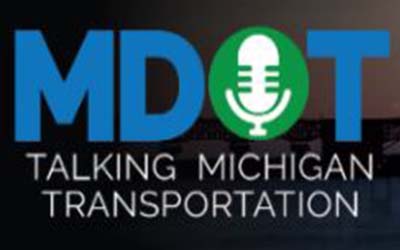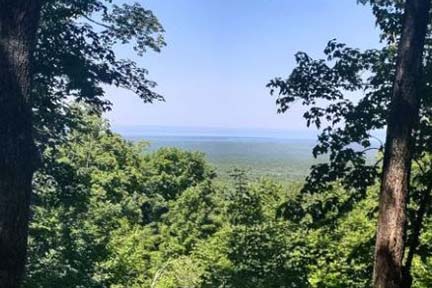
Students unveil creative artwork in MDOT’s Paint the Plow project

|
Students unveil creative artwork in MDOT’s Paint the Plow project to promote winter and road safety
LANSING, Mich. – Students from several schools throughout Michigan unveiled their vibrant artwork as part of the Michigan Department of Transportation’s (MDOT) annual Paint the Plow project. This initiative allows students to paint snowplow blades with designs that promote safe driving behavior and create awareness for the plow operators who work to keep Michigan’s roads free from snow and ice during the harsh winter months.
The creative and original decorated plow blades feature this year’s safety message, “Go hands-free. Just drive. It’s the law.” This year’s theme reminds road users that it is illegal to hold and use an electronic device while driving in Michigan. Each design not only highlights the artistic talents of Michigan students but also serves as a reminder of the importance of safe driving and Michigan’s goal of zero deaths on our roads.
“Seeing the creativity and passion of our students is inspiring,” said State Transportation Director Bradley C. Wieferich. “The Paint the Plow project is a fun and engaging way to encourage students to think about these important safety messages, while also allowing them to contribute to their community in a unique way.”
Participating schools include:
- Bay Region’s Heritage High School designed Blade of Glory.
- Grand Region’s Caledonia High School designed Snows Buddies Business.
- Superior Region’s Newberry High School designed Ice Force One.
- University Region’s Western High School designed Bob.
The painted plows will be visible along various state trunklines in Michigan through the winter, serving as both functional maintenance vehicles and striking reminders of the importance of safe driving practices. Beginning in late autumn, MDOT snowplow names and locations will be accessible on Mi Drive, the department’s construction and traffic information website. Mi Drive also allows motorists to view traffic cameras and speeds, locate incidents, and search for construction projects throughout Michigan. To locate MDOT plows in action, select the plow layer on Mi Drive. A list of complete snowplow names is available on the MDOT website. Paint the Plow applications and theme for the 2025-26 season will be available beginning in March 2025. Applications require a draft of the intended design and commitment from the school to complete the plow blade before the winter season. Applications are open to all Michigan high schools.
To help motorists prepare for the upcoming winter season, MDOT encourages all Michigan drivers to heed essential winter driving safety tips:
- Adjust your speed: Always drive for conditions. Snowy and icy conditions may mean slower speeds and an increase in following distances to allow for safe stopping.
- Stay alert: Always check the weather forecast and Mi Drive (Michigan.gov/Drive) before traveling.
- Prepare your vehicle: Keep your vehicle well maintained and stock it with supplies like an emergency kit and necessary fluids. Check out the Michigan State Police’s Winter Driving page for more tips.
- Respect snowplows: Give snowplows room to work safely. Michigan law now requires individuals to keep at least a 200-foot distance between their vehicle and a snowplow.
Together, let’s make this winter safe and enjoyable for everyone on Michigan’s roads.

Heritage High School art students proudly unveiled their creative design for MDOT’s 2024-2025 Paint the Plow program.

Caledonia High School senior art student, Josie D. Burns, proudly unveiled the school’s creative design for MDOT’s 2024-2025 Paint the Plow program.

Newberry High School art students proudly unveiled their creative design for MDOT’s 2024-2025 Paint the Plow program.

Western High School art students proudly unveiled their creative design for MDOT’s 2024-2025 Paint the Plow program.
###
Crash Not Accident
Note to reporters: Crashes are no accident, they are preventable. Please use “crash” instead of “accident” when reporting. Learn more at www.Michigan.gov/











 Secretary Benson spoke in Detroit ahead of the 2024 General Election to announce a new tool that will make election data more accessible to the public.
Secretary Benson spoke in Detroit ahead of the 2024 General Election to announce a new tool that will make election data more accessible to the public. Secretary Benson spoke at a news conference in Detroit to announce the Michigan Voting Dashboard, an interactive tool that will display daily election data.
Secretary Benson spoke at a news conference in Detroit to announce the Michigan Voting Dashboard, an interactive tool that will display daily election data. Secretary Benson smiled for a photo alongside students from UMSI, Scott Tenbrink, an instructor at UMSI; Canton Township Clerk Michael Siegrist, and Whitney Quesenbery, director of the Center for Civic Design (right).
Secretary Benson smiled for a photo alongside students from UMSI, Scott Tenbrink, an instructor at UMSI; Canton Township Clerk Michael Siegrist, and Whitney Quesenbery, director of the Center for Civic Design (right). Secretary Benson stood alongside (pictured from left to right) Siegrist, UMSI student Jackson Gelbard, Tenbrink, Quesenbery, and Secretary Benson.
Secretary Benson stood alongside (pictured from left to right) Siegrist, UMSI student Jackson Gelbard, Tenbrink, Quesenbery, and Secretary Benson.